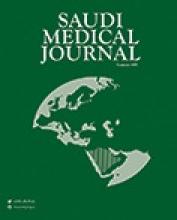Abstract
OBJECTIVE: To ascertain the causative organisms of community acquired pneumonia (CAP) in Jordanian patients requiring hospital admission.
METHODS: A prospective study of both adults and children admitted to Princess Basma and Princess Rahma Teaching Hospitals in Irbid, Jordan with a diagnosis of CAP over a 6-month period from April to October 2002.
RESULTS: A total of 35 adult patients were admitted with a mean age of 47 years, and 63 children with a mean age of 3 years. A pathogen was isolated from 25 (71%) adults, and from 17 (27%) children, and sputum cultures gave the best diagnostic yield. In adults Streptococcus pneumoniae was the most common isolate (26%), followed by Chlamydia pneumoniae (23%), Haemophilus influenzae (17%), Mycoplasma pneumoniae (9%), and Legionella pneumophila and Klebsiella pneumoniae (6%) each. Seven of the 9 gram negative isolates were from patients with some co morbid illness. While in children, Chlamydia pneumoniae was the most common (14%), followed by Mycoplasma pneumoniae (6%), and Streptococcus pneumoniae, Haemophilus influenzae, and Pseudomonas aeruginosa (3%) each.
CONCLUSION: Streptococcus pneumoniae and atypical microorganisms are the most common cause of CAP in previously healthy adults; while in those with associated co morbid illness, gram negative organisms are the likely cause. In children, the overall detection rate of causative organisms was low with atypical microorganisms being the most common.
- Copyright: © Saudi Medical Journal
This is an open-access article distributed under the terms of the Creative Commons Attribution-Noncommercial-Share Alike 3.0 Unported, which permits unrestricted use, distribution, and reproduction in any medium, provided the original work is properly cited.






